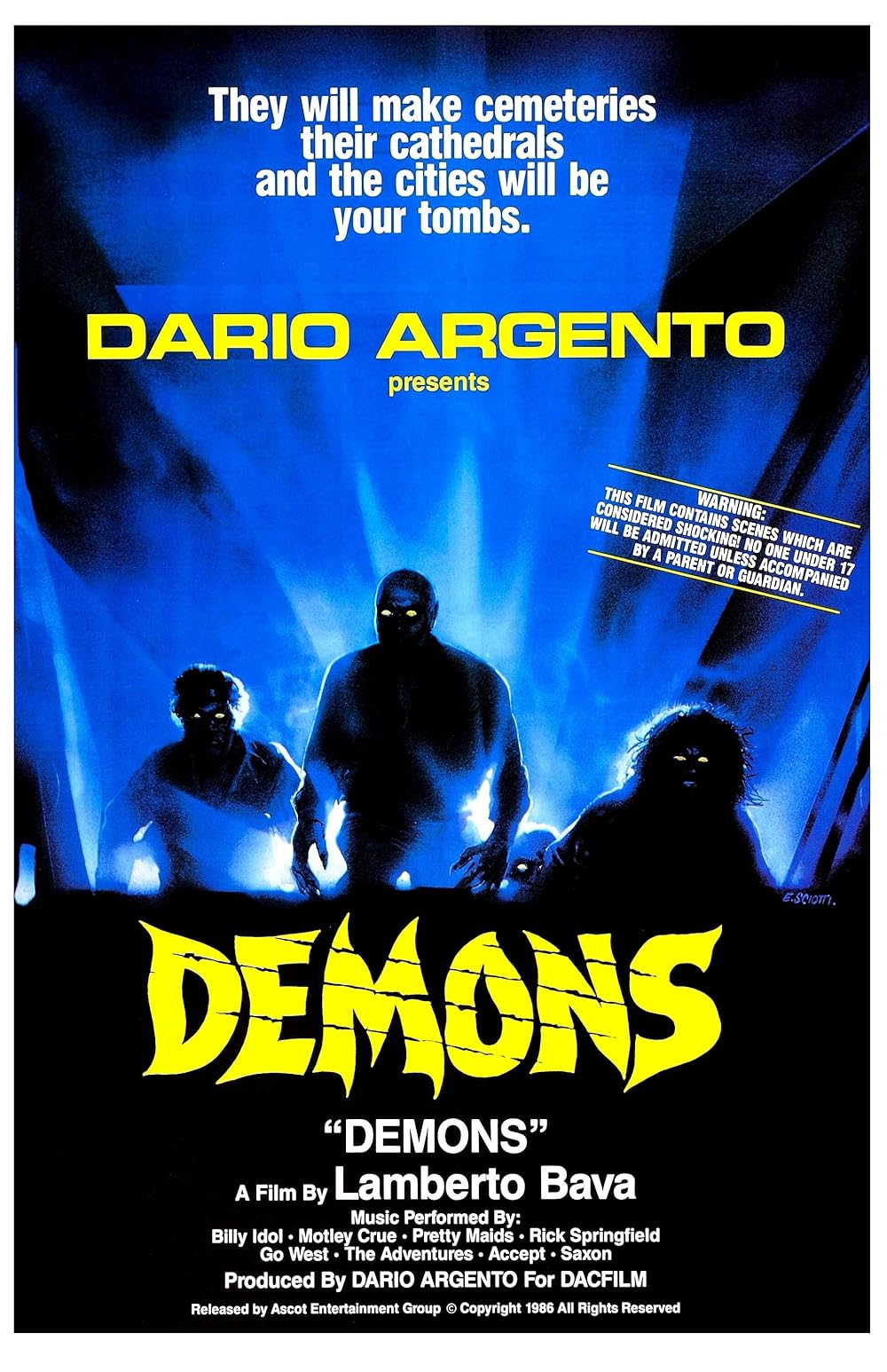
Masterpiece Theater returns, as DwC takes yet another in-depth look at what could be a classic, if only people would realize it – Demons. The 1985 Lamberto Bava effort was written by Bava, alongside Dardano Sacchetti, and the legendary Dario Argento.
What hidden depths will DwC find this time…
*spoiler warning*
Demons
After receiving an invitation to a private film screening from a strange, masked man, university students Cheryl and Kathy decide to skip class and attend. There, they meet George and Ken and settle in to watch the film. In the lobby, however, another attendee removes a mask from a prop display, puts it on, and cuts her face.
As the film begins, her cut starts bleeding, mirroring a scene in the film they are watching. She promptly excuses herself to the restroom, where she transforms into a bloodthirsty demon capable of spreading possession like a virus.
One by one, the filmgoers turn into demons while the dwindling number of humans find themselves trapped in the theater, where they must run, hide, or fight back to survive the onslaught. But even if they escape, what awaits them outside the confines of the theater…
The 1980s were a spectacular time for genre cinema, giving us some of the finest films ever made. A vast number of these films were made in Italy. Italian genre cinema had always been extremely profitable, going back as far as the late 1960s to the era of the spaghetti western and the birth of Poliziotteschi: highly stylized and often extremely violent crime and vigilante films featuring the most insane stunt work this side of The Road Warrior.
The early 70s saw an explosion in the Italian film industry when Giallo, a genre that combined noirish murder mystery plotlines with extreme horror, took off, and this carried over into the 80s as knockoffs of successful American horror movies were being made by the dozen.
This era of cinema produced many legendary directors on both sides of the pond: filmmakers such as John Carpenter, Dario Argento, and Lucio Fulci, just to name a few.
Then along came Lamberto Bava, who may as well be referred to as Jesus since his father, Mario Bava, was a God of cinema who made films so impossibly great and so influential that you could watch any one of them and spot a dozen scenes that other movies ripped off.
Lamberto Bava had several impressive films under his belt by 1985, but he would earn his seat at the table with the Greats when he released the subject of this analysis: Demons.
From the opening scene, Bava is toying with the perception of reality when filtered through a movie screen. Cheryl (Natasha Hovey) is on a subway in Berlin surrounded by punk rockers when she glances into the darkened tunnel through the window, doubling as a television screen, and sees a masked man (Michele Soavi). When she turns, he’s not there. Moments later she exits the train and sees the man on the platform, and he seems to be following her.
Thankfully, her fear is short-lived, for when he catches up to her, he hands her a ticket to a film screening. She asks him for another, for her friend, then inquires about his mask and if it’s part of the film promotion. Not in the mood for chit-chat, he just hands her another ticket and walks off. She convinces her friend Kathy (Paola Cozzo) to skip class and go to the movie with her, and Kathy agrees, because what harm could come from going to the movies?
The Metropol is a badass venue. Posters for the AC/DC concert film Let There Be Rock and Dario Argento’s Four Flies on Grey Velvet adorn the walls, and in the center of the lobby is a prop display featuring a samurai holding a sword in one hand, a mask in the other, and sitting atop a motorbike. These are odd things to be in a movie theater; I wonder if they’ll be involved in the plot later. *
*Spoiler alert: In one hour and eleven minutes, they will indeed be involved in the plot, in a scene that is literally the single greatest accomplishment in human history*
We then meet the supporting characters as they begin filing into the theater: George (Urbano Barberini) and Ken (Karl Zinni), who quickly introduce themselves to Cheryl and Kathy, forming our quartet of protagonists.
We meet Ingrid, the redheaded usher (Nicoletta Elmi) who appears to be checking out her own ass in the mirror, blind guy Werner (Alex Sera) and his date Liz (Sally Day), young couple Tommy (Guido Baldi) and Hannah (Dario Argento’s daughter, Fiore Argento), older couple Frank (Stelio Candilli) and Ruth (Nicole Tessier), who are celebrating their anniversary, and last but certainly not least, we meet the greatest Goddamned character in all of cinema: Tony the pimp (Bobby Rhodes).
Tony is accompanied by two of his ladies, Rosemary (Geretta Geretta) and Carmen (Fabiola Toledo). Forget about Sir Mix-a-Lot, because Bobby Rhodes is the one who met Clint Eastwood and slapped his momma. When Rosemary takes the mask from the samurai mannequin and cuts her face with it, Tony the pimp delivers the best admonishment I’ve ever heard:
“THAT’LL TEACH YOU TO TOUCH THINGS!”
They all take their seats, and the film begins with a voiceover:
“The sleep of reason gives birth to monsters”
Art buffs will recognize this as the title of a Francisco Goya aquatint, so you just know this shit is going to be classy as a bastard.
In the film within a film, four college-aged kids, Bob (Marcello Modugno) and Jerry (Michelle Soavi, the masked man from earlier), and their girlfriends Nancy (Jasmine Maimone) and Edith (Eliano Miglio), are cruising around on motorbikes listening to Motley Crue and looking for the crypt of Nostradamus, a name Nancy thinks sounds like a rap group. This is the most accurate depiction of a college student I’ve ever seen.
Also very accurate are the people acting like assholes in the theater: they smoke, the blind guy is making his lady describe everything that’s happening, the older guy who was sophisticated enough to take his wife to a free movie on their anniversary complains, and the young kids make out.
Also, the blind guy’s date, Liz, has her lover (Claudio Spadaro) show up, and they start making out right next to the poor bastard. Nothing is out of the ordinary until the movie characters find and open Nostradamus’ crypt, revealing an old book and a dirty mask. Bob, conveniently knowing how to read Latin, starts translating the book while Jerry puts the mask on.
Bob tries to stop him because according to the book, whoever wears the mask becomes a demon, but it’s too late; Jerry cuts his face, just like Rosemary did. In the seats, Rosemary’s cut starts to bleed, so she heads to the bathroom to tend to the wound. Carmen tells Tony the pimp that it’s a little weird that the cut started bleeding just as the guy in the movie cut his face, to which Tony sensitively replies:
“Ah, that’s a bunch of shit, baby.”
In the bathroom, Rosemary’s cut starts pulsating, forming a huge pustule that explodes and sprays pus and green shit all over the place. That will certainly teach her to touch things.
In the film within the film, Jerry has gone full demon and is killing the other characters. This scares Carmen, so she decides to go check on Rosemary, whom she finds cowering in a bathroom stall. Carmen asks if she’s ok, but Rosemary is now a demon and claws the shit out of Carmen’s throat, who escapes with Rosemary in hot pursuit.
The pace is staggering; we’re twenty-three minutes into the film, and you can rest assured that it doesn’t let up from here. Carmen manages to get away and make her way behind the movie screen.
Kathy hears her screams and realizes it’s not coming from the movie, but Ken insists it’s just the Dolby system. Nice product placement, Lamberto. She’s quickly proven correct in a brilliant scene staged by Bava in which the fictional horror of the film literally tears its way into reality.
Carmen’s nails cut into the fabric of the screen, and she spills out onto the stage to the shock of the patrons. Tony the pimp runs up to check on his lady, but she’s changing. There is no way to confirm if Tony the pimp learned English in the class taught by Harold Ramis in Stripes, so we’re forced to assume he did, as he jumps back and yells out:
“Son of a bitch! SHIT!”
The transformation rivals that of An American Werewolf in London: her fingernails split and sprout large talon-like claws, teeth fall out and are replaced by fangs, green goo spews from her neck wounds, and her veins blacken and become visible beneath her skin. Everyone is standing around in shock when the cheater dude drops from the balcony, hung by the neck.
Tony the pimp snaps out of it and screams for everyone to run away, presumably before he has to start doling out pimp slaps. Frank is too slow, though, and the demon leaps from the stage and tears his throat out.
Upstairs on the balcony, the blind guy is attacked by the other demon, who makes sure he’s really blind by gouging his eyes out. That’s not good enough though, so she swirls those long-ass claws around inside his mutilated ocular cavities.
The theatergoers make for the exit as speed metal blasts on the soundtrack, and they discover some supernatural force has walled off the exits. What follows can only be described as chaos. Characters panic, demons appear and claim more victims, and Tony the pimp, badass that he is, takes charge.
When a demon reaches through a doorway and tears Ruth’s scalp off, Tony the pimp pushes a soda machine against the door and cuts its damn fingers off. He then has an epiphany:
“It’s just like the movie, get it!”
Perhaps if they stop the movie, the demons will just… go away? He leads the survivors to the projection room, kicks the Goddamned door down, and they destroy the projectors. I’m sure everything will be fine now.
Outside, some punk rock kids, Ripper (Lino Salemme), Baby Pig (Peter Pitsch), Hot Dog (Giuseppe Cruciano), and Nina (Bettina Ciampolini), are driving around in a stolen car and snorting cocaine out of a Coca-Cola can, thus achieving the second greatest visual pun of 1985, second only to the greatest visual pun of all time from the same year: the “head giving head scene” in HP Lovecraft’s Re-Animator. If you haven’t seen that movie, shame on you.
And that’s it for these characters for now, so let’s head back to the theater.
The remaining humans have made their way to the balcony where, somehow, Werner the blind guy is still alive despite having two open gore-holes where his blind eyes used to be. He tells them that it’s not the film, it’s the theater, but Tony the pimp has no time for exposition and wants to throw Werner’s dead cheating girlfriend over the balcony.
He asks George to help him throw her over, declaring that the demons aren’t gonna get him, but George, the de facto hero who hasn’t done all that much heroic shit yet, refuses. Tony flies into a rage:
“You son of a bitch! YOU AIN’T WORTH SHIT!
Just then a demon, using the hanging guy as a ladder, hops over the railing and attacks, but Tony the pimp pulls out his pig sticker, flips the blade, and shreds it to ribbons. It falls back down and lands on the seats under which young Hannah is hiding, puking blood and pus all over her. It’s nasty, but Tommy saves her.
Tony the pimp is fully in charge now and directs everyone to start barricading the entrance to the balcony. Now this is a Goddamned hero, George, as long as Tony is calling the shots, there’s…
Oops, dead cheating demon Liz jumps up and attacks him, and they tumble off the balcony. Demonic bastards killed Tony the pimp.
Son of a bitch. Shit.
The punks in the car outside are listening to Billy Idol now and fighting over their can of coke, eventually spilling it and sending Ripper over the edge:
“Pick it up! Every gram!”
Hot Dog thinks the whole thing is hilarious, so he pretends to be gay and excited by Ripper’s toughness, enraging Ripper even more. That’s when Baby Pig notices some cocaine has landed in Nina’s cleavage, so of course, he has to retrieve it with a razor blade. This is getting her a little hot until Baby Pig cuts her, and she calls him a prick.
Now outside The Metropol, some cops show up to hassle them. They take off running, screaming “fuck off pigs!” in typical punk rock fashion, and head down a blind alley next to the theater. Just when you think the cops are gonna bust them, a door opens, and they head into The Metropol.
The cops, confused as to where they could have gone, see someone hiding behind a car. A demon has escaped the theater…
Inside, Tommy and Hannah pull a Die Hard and attempt to escape through the ductwork, but Tommy realizes too late that the noises he’s been hearing are coming from Hannah, who’s now a demon. There’ll be no snappy John McClaine-esque one-liners from Tommy.
The punks soon discover that they’re trapped, so Nina decides this is an opportune time to wander off and put on some lipstick, at which point demon Ruth makes quick work of her. The following is one of the best shots in the film and may be Lamberto’s way of paying homage to his father, Mario. The demons crest a staircase, backlit and in slow motion, and make their way down the hall, their eyes all aglow. It’s Goddamned glorious, and Tony the demon pimp is leading the way.
The survivors on the balcony hear the punks getting massacred by demons and mistake this for the sound of rescuers, so they start tearing down the barricade despite warnings from George and Ken. Once the barricade is weakened, the demons start bursting through and killing anyone they can get their claws on.
Pandemonium ensues as throats are ripped out, fingers are bitten off, and limbs are severed while our four heroes crawl out from under the barricade, now the only humans left alive in the theater. Kathy isn’t faring too well, however, as she’s mumbling incoherently and appears to be in shock.
The others are checking on her when we notice her eyes have changed color. She’s possessed, and in a tremendously effective practical effects showcase courtesy of Sergio Stivaletti, she births a demon. She falls to all fours, and blood starts soaking through her shirt, then the iconic horned demon that was plastered all over the film’s marketing material rips through her back and crawls out of her body like a Goddamned tarantula shedding its skin.
It disappears into the shadows, but not before clawing Ken’s chest. Damn man, that’s two main characters getting wasted in about 30 seconds. Ken knows he’s a goner and begs George to kill him with the samurai sword before he turns, but George urges him to fight the possession.
It’s no use; Ken turns, and George is finally forced to grow some balls and do something heroic for once. Ken lunges, George swings the sword, and blood sprays while Cheryl ducks into the auditorium to avoid seeing the aftermath. She’s suddenly surrounded by demons, and we think she’s done for, too, but the stage has been set; everything that has ever happened in the history of cinema has been building to this set piece.
George, after killing his best friend, and who, up to this point, has been an ineffectual little Nancy-boy, turns into the greatest action hero not named Arnold Schwarzenegger and jumps on the bike. Cheryl hears the engine roar, and then George rides to the rescue with sword in hand and chops their asses down.
A demon grabs the tire chain as George hits the throttle, severing its fingers. Just when we think this can’t get any cooler, a double kick drum is heard, and ‘Fast as a Shark’ by thrash-metal legends Accept starts blaring on the soundtrack. George proceeds to tear through the theater, slicing and dicing the demons who are diving at and over the bike.
He’s up and down the aisles, he’s riding atop the backs of the seats, and all with one hand so he can keep cutting up demonic sumbitches as limbs fly and blood sprays. The camera work is frenetic yet steady. Chaotic, but under Bava’s masterfully tight control.
Human language has not evolved a word to describe just how fucking awesome it is.
If this scene had gone on for 90 minutes, no one would have complained, but after a sharp turn, Cheryl falls off the bike. George hacks up a few more demons before going back for Cheryl, who just became spontaneously pregnant and is looking at him as if he were Chuck Norris, Lee Marvin, and Charles Bronson all mashed together into a single human being.
The majority of demons are dead, and they’re about to start making out in celebration when a helicopter crashes through the roof of the theater.
This shit is insane.
Luckily, the chopper is equipped with a grappling hook and cable that they can use to reach the rooftop, but not before the last few demons run into the room. George, who is now capable of using anything on the planet as a weapon, hits the ignition to bisect the remaining demons with the blades. They crawl up the cable to safety, but that weird guy with the mask is waiting for them. I guess he was just hanging out up there all night on the off chance that a helicopter would crash through the roof and someone would try to escape that way.
He pushes George back down through the hole in the roof, but George grabs some exposed rebar while the man toys with him. Just when we think George is finished, Cheryl runs the masked man through with a pipe and helps George up, where they grab a pole and employ a fulcrum and lever system to impale the guy’s head on a sharp piece of metal. Checkmate, fuck face. They climb down to the street and discover, to their horror, that demons are everywhere and the apocalypse has begun.
They start running away but quickly find themselves surrounded. Just then, a family of militants pulls up in a Jeep and shoots all the demons, especially the one who looks exactly like Mick Jagger.
That’s for Emotional Rescue, you dick
They’re going west. They saw some lights and reckoned there might be a pocket of civilization left. As the credits roll, they head on down the road.
Hold up, stop the credits; Cheryl is a demon. They blast her ass and drive away. Ok, now continue with the credits.
Now that’s a movie. Relentlessly paced and genuinely terrifying, with a touch of satire as Bava and his cohorts poke fun at the absurd notion, so prevalent in the 80s, that watching violent films makes one violent. The premise would be too on the nose if not handled so skillfully; people watch a movie about murderous demons and literally turn into murderous demons as a result. Its genius lies in its simplicity.
The talent assembled behind the camera is unparalleled: living legend Dario Argento, who, despite being the producer of the film, is often mistakenly credited with directing it (One needs only to go to the Shudder streaming service and look up the “Argento Collection” to see Demons listed alongside Tenebrae and Deep Red), Dardano Sacchetti, the mastermind behind dozens of screenplays, such as Lucio Fulci’s The Beyond and Mario Bava’s Shock to name but two, and Bava, a name synonymous with cinematic excellence.
These giants came together while firing on all cylinders and put together a perfect film, with a killer soundtrack stuffed with 80s speed metal greats like Motley Crue (before they got lame) and The Pretty Maids. Even Claudio Simonetti showed up to provide additional music fresh on the heels of his legendary prog rock band Goblin splitting up. The casting and performances are pitch-perfect, with Bobby Rhodes standing out as Tony the pimp.
Demons is a masterpiece worthy of celebration, but sadly, clouds were gathering and the winds of change were blowing. The Italian film industry was in steep decline as theaters were closing, and those that remained were mostly showing American films.
Italian studios shrank and began to rely on the burgeoning television market, but due to strict Italian censorship laws, adult-oriented material could only be shown on television very late at night, diminishing the potential for ad revenue. As a result, the studios tightened their purse strings and began reducing budgets significantly.
These monetary restraints greatly impacted the quality and quantity of Italian cinema. Even a master like Dario Argento was not immune, for in 1987, he released what is widely considered his last great film, Opera, and this lack of financing played a key role in the plummeting quality of his output.
Because Demons was such a massive hit, a sequel was immediately rushed into production, and it was this rushed production that would result in a film that, while still magnificent and boasting an even better soundtrack, couldn’t quite reach the lofty heights of its predecessor. Minor shortcomings aside, Demons 2 was also highly profitable, and the success of these films should have put Bava on the first train to A-list City, but alas, it just wasn’t in the cards for the man.
He showed great promise with his earlier films, and Demons is undoubtedly a masterpiece, but he just happened to come along at the wrong time, and opportunities to direct features were drying up. By 1989, just three short years after the colossal success of Demons and Demons 2, Bava would be directing made-for-TV films, a career path in Italy that one does not return from once taken.
His television career was no doubt lucrative, but the restrictions that came with it were creatively stifling. At the time of this writing, Bava is 80 years old and still directing TV movies. This golden era of cinema was coming to an end, but it was truly something special to behold.
From the mid-70s to the mid-80s, there was a tidal wave of excellent films coming out of Italy. It seemed like every other weekend another all-timer would open at the drive-in or appear on the shelves at the local mom-and-pop video store. Just a few short years after Demons was released, however, that tidal wave would be reduced to a trickle.
Those of us who were lucky enough to have lived through this brief, glorious moment in cinematic history will never forget it. Demons marked the beginning of the end, and we will assuredly never see anything like that era again. As brilliant as it is, it also marks an unfortunate turning point, “The high-water mark,” to quote Hunter S. Thompson…
“Where that beautiful wave finally broke and started to roll back.”
10 switchblade-wielding pimps out of 10
DwC
The post Masterpiece Theater: DEMONS (1985) appeared first on Last Movie Outpost.


